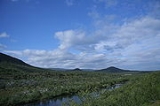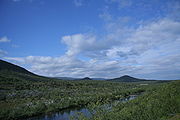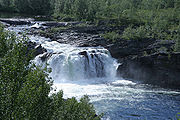
Stabbursdalen
Encyclopedia
Stabbursdalen National Park lies in North Norway. It contains the northern-most
Pine
Forest in the world. It is located in Porsanger
, Norway.
 The Stabbursdalen National Park contains many of Finnmark
The Stabbursdalen National Park contains many of Finnmark
`s typical landscape forms: barren mountains, open plateaux and narrow ravines, with scattered mountain birch
and stretches of pine forest. Waterfall
s and rapids interspersed with deep pools of still water mark the Stabbur river as it runs through the National Park. At Luobbal (Lompola) it sweeps gently into wide bays. The bare rugged mountains of Gaissene to the south-east contrast with the ancient undulating landscape to the north and west.
 Some 7,500–5,000 years ago when the climate
Some 7,500–5,000 years ago when the climate
was warmer, the pine forest spread far inland along the fjord
s and valley
s. As it grew colder, the forest retreated and has only survived in sheltered valleys like Stabbursdalen, where it forms the world's northernmost pine forest (Porsanger climate). Its protection is therefore one of the major objectives of this national park.
The woodland is open with low shrubby pine trees, in the far north trees grow slowly and are liable to frost and wind damage. The dry sterile soil
can only support a poor undergrowth of lichen
and heather
.
At Loubbal the wetlands form a fertile oasis in an otherwise barren landschape. Along the river, willow
and sedge
, with pine woodland behind, support a rich bird life. Stabbursdalen is the most northernly habitat
for many species, including black grouse
and osprey, and wetlands are important breeding ground, especially for ducks. Old hollow pine trees provide good nesting places for the goldeneye
and goosander.
 For the coastal Saami
For the coastal Saami
people sjøsamene, the natural resources of Stabbursdalen formed a significant part of their subsistence. Hunting
, fishing and collecting animal fodder have long traditions, but by careful harvesting few traces remain in the landscape. In Luobbal, sedge was previously cut for winter fodder, while tree stumps in the forest bear witness of timber
cut for building boats and houses. There are remains of pit-falls where wild reindeer
were hunted in the past, but domestic reindeer herding took over in the 17th century. Today, the area provides summer grazing for the reindeer.
) by a missionary in the 18th century (to replace the Sami languages
name Rávttosvuopmi). This was later misunderstood (by folk etymology) as "Stabbursdalen". The first element was then assumed to be the genitive of stabbur (but there has never been a building like that in the valley).
The world's most northern
This is a list of various northernmost things on earth.- Cities and settlements :See also: Northernmost settlements, Northernmost cities and towns-Geography:-Animals:-General:-Shrubs:-Trees:-Culture and music:-Sport :- Religion :...
Pine
Scots Pine
Pinus sylvestris, commonly known as the Scots Pine, is a species of pine native to Europe and Asia, ranging from Scotland, Ireland and Portugal in the west, east to eastern Siberia, south to the Caucasus Mountains, and as far north as well inside the Arctic Circle in Scandinavia...
Forest in the world. It is located in Porsanger
Porsanger
Porsanger or Porsáŋgu or Porsanki is a municipality in Finnmark county, Norway. The administrative centre of the municipality is the village of Lakselv...
, Norway.
The national park

Finnmark
or Finnmárku is a county in the extreme northeast of Norway. By land it borders Troms county to the west, Finland to the south and Russia to the east, and by water, the Norwegian Sea to the northwest, and the Barents Sea to the north and northeast.The county was formerly known as Finmarkens...
`s typical landscape forms: barren mountains, open plateaux and narrow ravines, with scattered mountain birch
Birch
Birch is a tree or shrub of the genus Betula , in the family Betulaceae, closely related to the beech/oak family, Fagaceae. The Betula genus contains 30–60 known taxa...
and stretches of pine forest. Waterfall
Waterfall
A waterfall is a place where flowing water rapidly drops in elevation as it flows over a steep region or a cliff.-Formation:Waterfalls are commonly formed when a river is young. At these times the channel is often narrow and deep. When the river courses over resistant bedrock, erosion happens...
s and rapids interspersed with deep pools of still water mark the Stabbur river as it runs through the National Park. At Luobbal (Lompola) it sweeps gently into wide bays. The bare rugged mountains of Gaissene to the south-east contrast with the ancient undulating landscape to the north and west.
The pine forest

Climate
Climate encompasses the statistics of temperature, humidity, atmospheric pressure, wind, rainfall, atmospheric particle count and other meteorological elemental measurements in a given region over long periods...
was warmer, the pine forest spread far inland along the fjord
Fjord
Geologically, a fjord is a long, narrow inlet with steep sides or cliffs, created in a valley carved by glacial activity.-Formation:A fjord is formed when a glacier cuts a U-shaped valley by abrasion of the surrounding bedrock. Glacial melting is accompanied by rebound of Earth's crust as the ice...
s and valley
Valley
In geology, a valley or dale is a depression with predominant extent in one direction. A very deep river valley may be called a canyon or gorge.The terms U-shaped and V-shaped are descriptive terms of geography to characterize the form of valleys...
s. As it grew colder, the forest retreated and has only survived in sheltered valleys like Stabbursdalen, where it forms the world's northernmost pine forest (Porsanger climate). Its protection is therefore one of the major objectives of this national park.
The woodland is open with low shrubby pine trees, in the far north trees grow slowly and are liable to frost and wind damage. The dry sterile soil
Soil
Soil is a natural body consisting of layers of mineral constituents of variable thicknesses, which differ from the parent materials in their morphological, physical, chemical, and mineralogical characteristics...
can only support a poor undergrowth of lichen
Lichen
Lichens are composite organisms consisting of a symbiotic organism composed of a fungus with a photosynthetic partner , usually either a green alga or cyanobacterium...
and heather
Calluna
Calluna vulgaris is the sole species in the genus Calluna in the family Ericaceae. It is a low-growing perennial shrub growing to tall, or rarely to and taller, and is found widely in Europe and Asia Minor on acidic soils in open sunny situations and in moderate shade...
.
At Loubbal the wetlands form a fertile oasis in an otherwise barren landschape. Along the river, willow
Willow
Willows, sallows, and osiers form the genus Salix, around 400 species of deciduous trees and shrubs, found primarily on moist soils in cold and temperate regions of the Northern Hemisphere...
and sedge
Cyperaceae
Cyperaceae are a family of monocotyledonous graminoid flowering plants known as sedges, which superficially resemble grasses or rushes. The family is large, with some 5,500 species described in about 109 genera. These species are widely distributed, with the centers of diversity for the group...
, with pine woodland behind, support a rich bird life. Stabbursdalen is the most northernly habitat
Habitat (ecology)
A habitat is an ecological or environmental area that is inhabited by a particular species of animal, plant or other type of organism...
for many species, including black grouse
Black Grouse
The Black Grouse or Blackgame is a large bird in the grouse family. It is a sedentary species, breeding across northern Eurasia in moorland and bog areas near to woodland, mostly boreal...
and osprey, and wetlands are important breeding ground, especially for ducks. Old hollow pine trees provide good nesting places for the goldeneye
Goldeneye (duck)
Goldeneye are small tree-hole nesting northern hemisphere seaducks belonging to the genus Bucephala. Their plumage is black and white, and they eat fish, crustaceans and other marine life....
and goosander.
People in the park

Sami people
The Sami people, also spelled Sámi, or Saami, are the arctic indigenous people inhabiting Sápmi, which today encompasses parts of far northern Sweden, Norway, Finland, the Kola Peninsula of Russia, and the border area between south and middle Sweden and Norway. The Sámi are Europe’s northernmost...
people sjøsamene, the natural resources of Stabbursdalen formed a significant part of their subsistence. Hunting
Hunting
Hunting is the practice of pursuing any living thing, usually wildlife, for food, recreation, or trade. In present-day use, the term refers to lawful hunting, as distinguished from poaching, which is the killing, trapping or capture of the hunted species contrary to applicable law...
, fishing and collecting animal fodder have long traditions, but by careful harvesting few traces remain in the landscape. In Luobbal, sedge was previously cut for winter fodder, while tree stumps in the forest bear witness of timber
Timber
Timber may refer to:* Timber, a term common in the United Kingdom and Australia for wood materials * Timber, Oregon, an unincorporated community in the U.S...
cut for building boats and houses. There are remains of pit-falls where wild reindeer
Reindeer
The reindeer , also known as the caribou in North America, is a deer from the Arctic and Subarctic, including both resident and migratory populations. While overall widespread and numerous, some of its subspecies are rare and one has already gone extinct.Reindeer vary considerably in color and size...
were hunted in the past, but domestic reindeer herding took over in the 17th century. Today, the area provides summer grazing for the reindeer.
The name
The valley was first named "Tabors dal" (after Mount TaborMount Tabor
-Places:*Mount Tabor, a hill in Israel near Nazareth believed by many to be the site of the Transfiguration of ChristIn the United States:*Mount Tabor, Indiana, an unincorporated community...
) by a missionary in the 18th century (to replace the Sami languages
Sami languages
Sami or Saami is a general name for a group of Uralic languages spoken by the Sami people in parts of northern Finland, Norway, Sweden and extreme northwestern Russia, in Northern Europe. Sami is frequently and erroneously believed to be a single language. Several names are used for the Sami...
name Rávttosvuopmi). This was later misunderstood (by folk etymology) as "Stabbursdalen". The first element was then assumed to be the genitive of stabbur (but there has never been a building like that in the valley).

